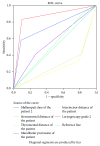Predictive Values of Preoperative Tests for Difficult Laryngoscopy and Intubation in Adult Patients at Tikur Anbessa Specialized Hospital
- PMID: 31065265
- PMCID: PMC6466924
- DOI: 10.1155/2019/1790413
Predictive Values of Preoperative Tests for Difficult Laryngoscopy and Intubation in Adult Patients at Tikur Anbessa Specialized Hospital
Abstract
Introduction: The significance of difficult or failed tracheal intubation following induction is a well-recognized cause of morbidity and mortality in anesthetic practice. Nevertheless, the need to predict potentially difficult tracheal intubation has received a little attention. During routine anesthesia, the incidence of difficult tracheal intubation has been estimated at 1.5%-8% of general anesthetics. Difficulties in intubation have been associated with serious complications, such as brain damage or death, particularly when failed intubation has occurred. Occasionally, in a patient with a difficult airway, the anesthetist is faced with the situation where mask ventilation proves difficult or impossible. This is one of the most critical emergencies that may be faced in the practice of anesthesia. If the anesthetist can predict which patients are likely to prove difficult to intubate, he/she may reduce the risks of anesthesia considerably. In Ethiopia, there are no data on the magnitude of difficult laryngoscopic tracheal intubation and no standard guidelines for preoperative tests. The main concern of this study was to provide information on the magnitude of difficult laryngoscopic intubation and to determine valuable preoperative tests to predict difficult laryngoscopy and intubation in patients with apparently normal airways which can help anesthetists to improve preoperative airway assessment and contribute to decrease anesthesia-related morbidity and mortality.
Objective: The main objective of this study was to assess the magnitude and predictive values of preoperative tests for difficult laryngoscopy and intubation, among surgical patients who underwent elective surgery under general anesthesia with endotracheal intubation in Tikur Anbessa Hospital from February 1 to March 30, 2016.
Study design: A facility-based cross-sectional study design was used.
Result: In this study, we found the magnitude of difficult laryngoscopy and intubation as 13.6% and 5%, respectively. 33.3% of patients with difficult laryngoscopy were found to be difficult for intubation. Mallampati test, interincisor distance, and thyromental distance were identified to be good preoperative tests to predict difficult laryngoscopic intubation when used in combination.
Recommendation: We recommend anesthesia professionals to use combination of MMC/TMD/IID for their routine preoperative airway assessment.
Figures




Similar articles
-
Assessment of predictors for difficult intubation and laryngoscopy in adult elective surgical patients at Tikur Anbessa Specialized Hospital, Ethiopia: A cross-sectional study.Ann Med Surg (Lond). 2022 Apr 28;77:103682. doi: 10.1016/j.amsu.2022.103682. eCollection 2022 May. Ann Med Surg (Lond). 2022. PMID: 35638080 Free PMC article.
-
The evaluation of maximum condyle-tragus distance can predict difficult airway management without exposing upper respiratory tract; a prospective observational study.BMC Anesthesiol. 2021 Jan 25;21(1):28. doi: 10.1186/s12871-021-01253-5. BMC Anesthesiol. 2021. PMID: 33494705 Free PMC article.
-
The diagnostic value of the upper lip bite test combined with sternomental distance, thyromental distance, and interincisor distance for prediction of easy laryngoscopy and intubation: a prospective study.Anesth Analg. 2009 Sep;109(3):822-4. doi: 10.1213/ane.0b013e3181af7f0d. Anesth Analg. 2009. PMID: 19690252
-
Preoperative airway assessment - experience gained from a multicentre cluster randomised trial and the Danish Anaesthesia Database.Dan Med J. 2016 May;63(5):B5241. Dan Med J. 2016. PMID: 27127020 Review.
-
Predictive parameters of difficult intubation in thyroid surgery: a meta-analysis.Minerva Anestesiol. 2020 Mar;86(3):317-326. doi: 10.23736/S0375-9393.19.14127-2. Epub 2020 Jan 8. Minerva Anestesiol. 2020. PMID: 31922378
Cited by
-
Ultrasound Guided Measurement of Anterior Neck Tissue for the Prediction of Difficult Airway: A Prospective Observational Study.Rom J Anaesth Intensive Care. 2022 Dec 29;28(2):105-110. doi: 10.2478/rjaic-2021-0018. eCollection 2021 Dec. Rom J Anaesth Intensive Care. 2022. PMID: 36844111 Free PMC article.
-
The prevalence of difficult airway and its associated factors in pediatric patients who underwent surgery under general anesthesia: An observational study.SAGE Open Med. 2021 Oct 20;9:20503121211052436. doi: 10.1177/20503121211052436. eCollection 2021. SAGE Open Med. 2021. PMID: 34691473 Free PMC article.
-
Assessment of predictive value of thyromental height in predicting difficult laryngoscopy compared with Mallampati, and thyromental distance among surgical patient who will take general anesthesia at selected governmental hospital cross-sectional study: Ethiopia, 2022.Ann Med Surg (Lond). 2024 Jul 31;86(9):5112-5119. doi: 10.1097/MS9.0000000000002388. eCollection 2024 Sep. Ann Med Surg (Lond). 2024. PMID: 39239027 Free PMC article.
-
Machine Learning Predictions and Identifying Key Predictors for Safer Intubation: A Study on Video Laryngoscopy Views.J Pers Med. 2024 Aug 25;14(9):902. doi: 10.3390/jpm14090902. J Pers Med. 2024. PMID: 39338156 Free PMC article.
-
Comparison of sensitivity, specificity, and accuracy of Wilson's score and intubation prediction score for prediction of difficult airway in an eastern Indian population-A prospective single-blind study.J Family Med Prim Care. 2020 Mar 26;9(3):1436-1441. doi: 10.4103/jfmpc.jfmpc_1068_19. eCollection 2020 Mar. J Family Med Prim Care. 2020. PMID: 32509629 Free PMC article.
References
-
- Apfelbaum J. L., Hagberg C. A., Caplan R. A., et al. Practice guidelines for management of the difficult airway: an updated report by the american society of anesthesiologists task force on management of the difficult airway. Anesthesiology. 2013;118(2):251–270. doi: 10.1097/aln.0b013e31827773b2. - DOI - PubMed
-
- Sunanda G., Rajesh S., Dimpel J. Airway assessment: predictors of difficult airway. Indian Journal of Anaesthesia. 2005;49(4):257–262.
-
- Stephen P., Fisher A. M. Preoperative evaluation. In: Miller R. D., editor. Miller’s Anesthesia. 7th. Canada: Elsevier Sounders; 2010.
LinkOut - more resources
Full Text Sources

